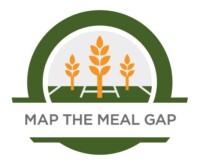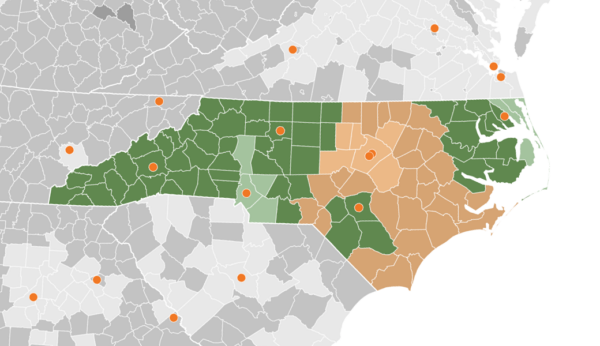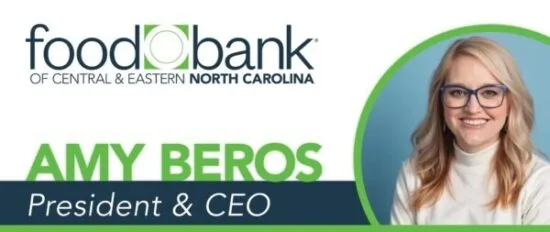New data reveals a worsening hunger crisis in North Carolina and nationwide — as food insecurity reaches its highest level in nearly 20 years.
According to Feeding America’s annual Map the Meal Gap analysis, more than 607,000 people are now food insecure across the Food Bank of Central & Eastern North Carolina’s 34-county area service area — nearly 47,000 more than the prior year. The analysis underscores the serious impact of cuts to federal support as the cost of housing, food and other essentials continue to rise here in North Carolina.
The hunger crisis has continued to worsen each year in the wake of the pandemic, as government has stepped back from investments in emergency food purchases and direct support for affected families. Yet despite deepening challenges, federal officials have gone even further by eliminating food purchase funding and forcing significant cuts to SNAP grocery support. As a result, 1 in 7 people across our region are now unsure where their next meal might come from, including nearly 1 in 5 children and teenagers.

“This data confirms what we’ve long heard from people facing food insecurity in North Carolina: the loss of federal and state support couldn’t come at a worse time. The Food Bank Network has seen a sharp increase in demand for emergency food assistance over the past year — and that’s a direct result of the rising cost of living and cuts to critical support programs.”
– Amy Beros, President & CEO
Food Bank’s 34-county service area:
607,630 people are food insecure
- 1 in 7 individuals (14.5%)
- 46,720 more than prior year
168,100 under 18 are food insecure
- 1 in 5 kids and teens (18.3%)
- held steady compared to prior year
Significant disparities across race
- 1 in 4 Black households (28%)
- 1 in 4 Latino/a/e households (23%)
- 1 in 9 White households (11%)
Statewide across North Carolina:
1,627,360 people are food insecure
- 1 in 7 individuals (15%)
- 133,490 more than prior year
438,200 under 18 are food insecure
- 1 in 5 kids and teens (18.9%)
- held steady compared to prior year
341,742 older adults are food insecure
- 1 in 12 individuals (8%)
- 13,343 more than prior year
SIGNIFICANT DISPARITIES ACROSS RACE
Food insecurity impacts people in every county and congressional district across North Carolina. Yet the new data also shines a spotlight on ongoing, deeper challenges in communities that have faced systemic barriers and exclusion for generations. For example, the number of Black (28%) and Latino/a/e (23%) households facing food insecurity is more than double that of White (11%) households statewide. These persistent racial disparities are influenced by factors like unemployment and poverty rates, as well as policies and practices rooted in history that continue to hold communities of color back today.
MEAL COSTS REMAIN OUT OF REACH
Across central and eastern North Carolina, the average cost of a single meal for food insecure individuals remained high at $3.65 — 10.6% higher than the peak of the pandemic. This rising cost of living has driven a weekly $22.80 “food budget shortfall,” the amount of additional money people facing hunger would need to provide to three meals a day all week. Without significant action and investment to restore vital safety nets, this shortfall will lead children, adults and seniors to miss more than 115 million meals annually in our region — the highest figure we’ve seen in nearly 20 years.
RESOURCES
Despite mounting challenges, it is important for people facing hunger to know that food remains available to all who need it. Our network of 700+ pantries, no-cost markets, meal sites, and delivery programs is moving mountains to ensure nutritious food reaches hard-hit communities. And everyone is welcome, no matter where we live, where we’re from, who we love, or the color of our skin. Find locations near you, as well as resources to sign up for SNAP (food stamps), WIC and senior meal programs.
OPPORTUNITIES
For those of us who are in a position to give, it has never been more important to get involved in the fight to end hunger and its root causes. Thanks to longtime partnerships with farmers, manufacturers, and retailers, the Food Bank can provide five meals for every dollar donated — far more than any of us could purchase as an individual consumer. And time is equally important; in the average volunteer shift, a single person will sort and pack enough food to fuel more than 160 meals for local families.
STUDY & METHODOLOGY
Map the Meal Gap is the only study that provides local-level estimates of food insecurity and food costs for every county and congressional district. The study builds upon the USDA’s latest report of national and state data, which showed a sharp increase in food insecurity in the midst of historically high food prices and the sunset of many pandemic-era programs. Map the Meal Gap uses publicly available data from the USDA ERS, U.S. Census Bureau, and Bureau of Labor Statistics to estimate local food insecurity at the county, congressional district and state levels. The study also estimates local meal costs and food budget shortfalls using food price data from NIQ based on the USDA Thrifty Food Plan, along with grocery sales tax data for every county and state in the country. The full report and executive summary can be found on the national Map the Meal Gap site.



